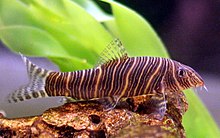
Cobitidae, also known as the True loaches, is a family of Old World freshwater fish. They occur throughout Eurasia and in Morocco, and inhabit riverine ecosystems. Today, most "loaches" are placed in other families. The family includes about 260 described species. New species are being described regularly.

The clown loach, or tiger botia, is a tropical freshwater fish belonging to the botiid loach family. It is the sole member of the genus Chromobotia. It originates in inland waters in Indonesia on the islands of Sumatra and Borneo. It is a popular fish in the freshwater aquarium trade and is sold worldwide.

The dwarf loach, ladderback loach, pygmy loach, chain loach or chain botia, is a freshwater fish belonging to the family Botiidae. Formerly included in the genus Yasuhikotakia, it is frequently seen in the aquarium trade, the product of captive breeding.

The Burmese Border loach, angelicus loach or polka dot loach, Botia kubotai, is a recently described species that has quickly become a popular tropical fish for freshwater aquariums. In 2002, fish collectors working in western Thailand began to expand their search into Myanmar (Burma) area from the Three Pagodas Pass Thai-Myanmar border to look for new fish for the aquarium trade. This is one of several species discovered and explains the origin of the fish's common name: Burmese Border Loach. Its specific epithet honors Katsuma Kubota of an aquarium export company in Thailand who first purchased the catch and sent them out for identification.
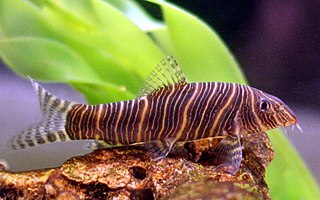
The zebra loach is a freshwater loach native to rivers and streams in the Western Ghats of India. The maximum size is about 9 cm (3.5 in). It lives in tropical climate with temperature range of 21–26 °C (70–79 °F), and prefers water with 6.0 to 7.5 pH.
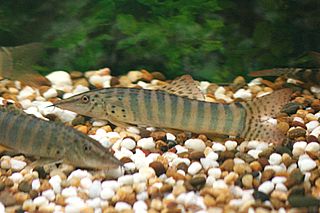
Syncrossus berdmorei is a freshwater fish in the loach family Botiidae. It is native to streams and rivers in Thailand, Burma, and nearby parts of northeastern India, where typically found over a soft bottom near boulders and submerged trees. Syncrossus berdmorei grows up to 10 in (25 cm) and can be kept in private aquariums.

The yoyo loach, Almora loach or Pakistani loach is a freshwater fish belonging to the loach family Botiidae. It originates in the slow-running and still waters of the Ganges basin in northern India and possibly Nepal. Despite the alternative common name Pakistani loach, the true B. almorhae is not known from Pakistan.

Yasuhikotakia is a genus of botiid loaches, many which are popular aquarium fish. It is named in honor of Japanese collector/researcher Dr. Yasuhiko Taki. This genus has been separated from the genus Botia in the paper by Maurice Kottelat in 2004.
Acanthocobitis is a genus of freshwater ray-finned fish of the stone loach family, Nemacheilidae. Recent work has suggested that the genus be split into two with the subgenus Paracanthocobitis being raised to a full species, leaving just the type species, Acanthocobitis pavonacea, in the current genus.

Schistura is a genus of fish in the stone loach family Nemacheilidae native to the streams and rivers of the southern and eastern Asia. Some of these species are troglobitic.

Yasuhikotakia modesta is a tropical freshwater fish of the family Botiidae. It is native to large rivers in Thailand, Laos, Cambodia, and Vietnam. The blue botia is a widely available fish in the aquarium trade and can be purchased globally.

Botiidae is a family of cypriniform ray-finned fishes from South, Southeast, and East Asia. Until recently they were placed in the true loach family Cobitidae, until Maurice Kottelat revised the loaches and re-elevated this taxon to family rank in 2012. The family includes about 56 species.

Schistura mahnerti is a species of tropical freshwater fish of the stone loach family Nemacheilidae. It inhabits fast-flowing streams of Thailand and Myanmar (Burma). S. mahnerti is one of the more recent species to be introduced to the aquarium trade.

Loaches are fish of the superfamily Cobitoidea. They are freshwater, benthic (bottom-dwelling) fish found in rivers and creeks throughout Eurasia and northern Africa. Loaches are among the most diverse groups of fish; the 1249 known species of Cobitoidea comprise about 107 genera divided among nine families.

Botia udomritthiruji is a small freshwater fish in the loach family Botiidae native to the Great Tenasserim (Tanintharyi) River Basin in south Burma. It reaches 13–15 cm (5.1–5.9 in) in length, and the female's abdomen plumper than the abdomen of the male.
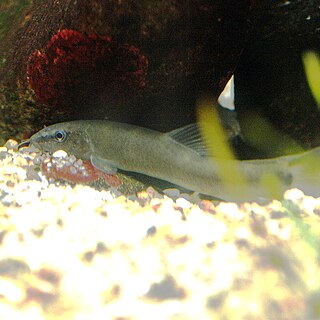
Parabotia is a genus of loaches. Most species in the genus are endemic to China, but P. curtis is from Japan, P. dubius is from Vietnam, and P. mantschuricus is from the Amur River basin.
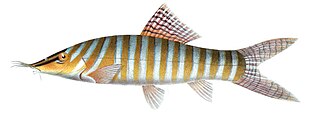
Syncrossus is a genus of six loaches, many of which are popular in the aquarium fish trade. They are primarily found in Southeast Asia, but S. berdmorei also occurs marginally outside this region in far northeastern India. It is one of eight genera in its family.

Botia rostrata, the Gangetic loach, ladder loach, or twin-banded loach, is a freshwater fish belonging to the loach family Botiidae. It originates in calmer water pool areas of highland streams in the lower Ganges and Brahmaputra basins in Bangladesh and north India. Records from elsewhere are believed to be misidentification of relatives. It is not as common in the aquarium trade as the clown loach or yoyo loach.
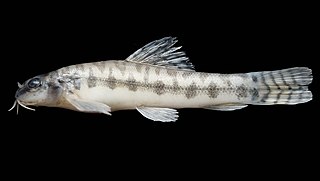
Paracanthocobitis is a genus, or subgenus, of freshwater fish in the family Nemacheilidae. This genus is known from the Indus basin in Pakistan to the Mekong basin of Cambodia and Laos The type species is Paracanthocobitis zonalternans. Some authorities treat this as a subgenus of Acanthocobitis and Fishbase only includes the five species described in 2015 by Singer & Plant, meaning that P. (A). zonalternans is not the type species.

Synocrossus beauforti, the barred loach,chameleon loach or chameleon botia, is a species of freshwater fish from the loach family Botiidae which is found in mainland south-east Asia.
